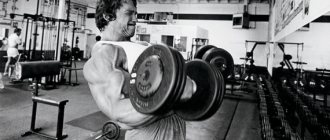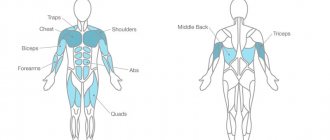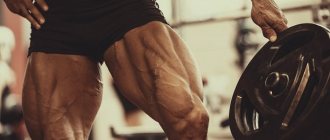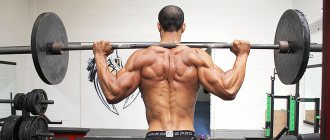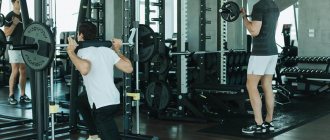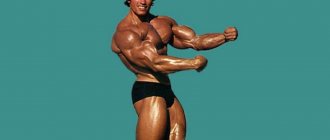First of all, this is high-repetition training with long-term aerobic exercises. Training with light weights and repetitions per set causes increased secretion of growth hormone, which is the main “fat burner” in our body. It is also worth noting that its effect does not stop even during rest, that is, the body, as if by inertia, continued to burn subcutaneous fat with a given intensity.
However, such training also carries a very serious disadvantage - the production of cortisol. This is released in response to stress loads endured by the body, and its purpose is to break down muscles. It is for this reason that gaining “relief” has always been accompanied by the loss of kilograms of muscle mass. It was an inevitable sacrifice, a kind of payment for “relief”. After many tests, scientists came to sensational conclusions: aerobics should be abandoned!
As for strength programs, a completely different scheme is proposed here, which has replaced high-repetition training in combination with aerobic exercise. They didn’t attempt multi-repetition training, but they changed it somewhat in comparison with the usual scheme.
Weight should be increased from week to week. Only in this case will strength training be in the full sense of strength. This will also lead to increased secretion of testosterone, which will not only stimulate muscle growth, but will suppress the secretion of its “competitor” - cortisol. This is precisely what the main discovery of scientists is connected with: the preservation of muscle mass while gaining “relief”, and not just preservation, but even a slight increase. Note: Follow the training intensity plan exactly.
It is measured as a percentage of your working weights for 10 repetitions. For example, if you bench press kg for 10 reps, then in the first week your working weight is 30 kg for 20 reps in 3 sets.
Skip to content. So, let's highlight 3 basic rules: Using high-repetition training, increase the weight from week to week.
High repetition and low repetition: training for mass and relief
Another stumbling block in the sports environment. A huge number of trainers rely on high-repetition training, I advise you to do everything with 30 pop-ups, 50 squats and everything like that. Everyone is afraid of low repetitions with more serious weights, because “huge muscles will be pumped up.” But you and I are adequate people, so now let’s analyze these training styles and note all the pros and cons.
It is customary to call high-repetition training - relief training, and low-repetition training - mass training. Probably, this all came from the authoritative opinion of “experts” who themselves had never been to the gym in their lives. No, well, everything seems logical: you squat 6 times and your buttock will grow! And you sit down 25 times and bam, all the fat has come off from all places, your butt is like a faucet, your abs are all gone. So, alas and ah, muscle growth is affected only by your physical work, a gradual increase in working weights and a nutritional surplus, and not by any exercises as such . The same goes for terrain training.
10 Best Psychology Books You Should Read
How do muscles generally grow, so to speak, how do we build mass ? If necessary, the body can increase its muscles. The stress experienced by the body during training leads to various changes, both in the muscles themselves and in all other systems. In muscles, reserves of energy sources - creatine phosphate and glycogen . Due to a sharp increase in anaerobic glycolysis - the process of energy supply - the chemical composition of muscle fibers changes. The content of adenosine diphosphate, creatine, hydrogen ions, and lactate increases. In addition, microtraumatization of individual muscle fibers can occur, and various protein structures are destroyed. The nervous and neuromuscular systems receive a significant load (by the way, vitamin C helps cope with it).
An additional burden falls on the endocrine system, which is forced to secrete, with special diligence, in increased quantities, first hormones responsible for the urgent supply of reserve energy sources, and then hormones that include restorative, synthetic (construction) processes. The cardiovascular and respiratory systems are not left out. Now attention! If the load that the body has received is greater than usual, habitual for it, then the central nervous system, having recorded and “processed” information about this, “turns on” the mechanism of general adaptation, expressed in measures aimed at counteracting a specific type of load and general, unrelated It is with this load that adaptive reactions occur.
Ugh, what a bore! Let's just say: your muscles get stressed and your body wants to avoid this at all costs next time. The main point is that you cannot pump up an individual muscle: for example, your butt will not grow without legs, even if you kill yourself! Only in this case, the overall load on the body will cause a “hormonal storm” to arise, as a result of which it will become possible to urgently supply energy, and then restore spent energy reserves and synthesize those protein structures for which there was a special need (including muscles). By the way, such It is heavy, basic exercises . It is as part of urgent adaptive reactions that muscle growth occurs. And after the affected body systems are restored to their previous level, the process will continue and, no longer becoming a restoration, but a super-restoration, will bring them to a new level, higher than it was at the beginning.
How to make your body sculpted? Work hard in the gym and eat with a calorie deficit and you will have this desired body contour. But in order for there to be relief (relief is actually visible muscles), muscles are needed . Yes, yes, it seems obvious, but for some reason not only everyone understands this and stubbornly asks “what is the training program for relief?” or even more trenchantly “what kind of training for relief”
